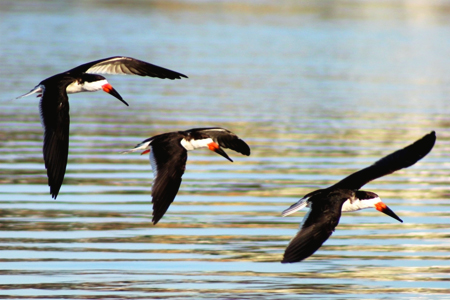The ecology of black skimmers in South America
South American black skimmers breed inland along rivers but spend the non-breeding period along the coast and very little is known about the species' when on the coast during the non-breeding season. They are very difficult to catch at that stage which requires different ways to look at the species’ ecology. This study used a combination of photographs, discarded feathers and citizen science data to gain new insights into that little known stage of the annual cycle. Using photography of birds with open wings we were able to determine when skimmers moult their flight feathers. Field photographs also allow for a reliable identification of the sex of the birds.
This allowed us then to identify the geographical areas where skimmers moult along the Brazilian coast. Citizens can deposit their bird photographs to the Wikiaves database which then provided a valuable source of information on time and location of moulting birds.
Moulting black skimmers will leave moulted feathers behind to be used to identify the sources the birds consumed when that feather was grown. We managed to collect feathers over three years with one of these years coinciding with a strong ENSO event. This allowed us to study the effect of ENSO on the numbers and diet of black skimmers using an important no no-breeding area in southern Brazil. During a strong ENSO event black skimmers altered where they foraged and the number of black skimmers staying in the area were higher during the ENSO period than in the equivalent months in a regular year.
Researchers
Bianca Vieira
Outputs
Vieira, B. P.; Furness, R. W.; Nager, R. G. 2017. Using field photography to study avian moult. Ibis 159: 443-448. doi: 10.1111/ibi.12445 [http://onlinelibrary.wiley.com/doi/10.1111/ibi.12445/abstract]
Vieira, B. P.; Furness, R. W.; Nager, R. G. In press. Visual Observation to identify sexes in adult Black Skimmers. Waterbirds.
Funding
CAPES Scholarship, Brazil

